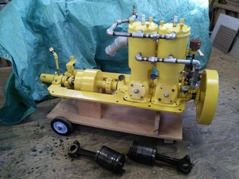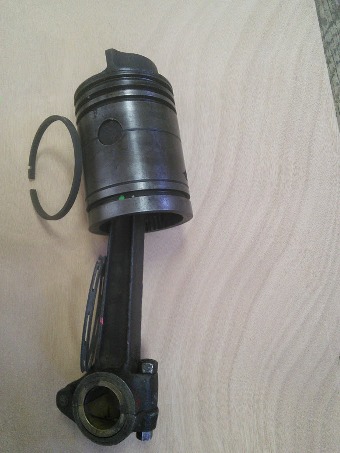|
| Author |
Message |
    
eric524
New member
Username: eric524
Post Number: 1
Registered: 02-2017
| | Posted on Monday, February 20, 2017 - 04:59 pm: | 




|
I pulled this engine from the bottom of a local lake some years ago. I have loosely reassembled the bits and pieces for purposes of identification. Does it look familiar to anyone out there? (no manufacturer's plate or other identifying marks) I have been working seriously on it - as seriously as a rank amateur can - for the last year or two. My current challenge is the rings. The photo shows the arrangement.As you can see, all of the old ones were pinned (and angled at the ends), including the oil ring at the bottom. I am not sure what to do about the oil rings. One opinion I have heard is that oil rings should not be pinned, but left free to do their work by rotating in their grooves.Clearly, that was not the case when this engine was built. The other problem is that if I go for pinning I will run into problems (breakage) by filing pin slots into them, because they already look fragile with their machined surface grooves and see-through slots. Would anyone be able be able to help this know-nothing amateur with this problem? Many thanks.
  |
    
jb_castagnos
Senior Member
Username: jb_castagnos
Post Number: 1279
Registered: 07-2002

| | Posted on Monday, February 20, 2017 - 07:36 pm: | 




|
The bottom ring is not an oil ring, it's to seal the piston skirt for crankcase compression, necessary in a two stroke to charge the cylinder. They were not always pinned because they don't cross the ports. On a two stroke the rings that cross the ports are pinned to keep the ends from rotating into the port area and getting caught. The bottom ring should be just like the others, not an oil ring. Replacement rings are often thicker, causing a lot of excess drag. If they are thicker, it would be beneficial to have someone machine the inside to reduce the tension, usually about .030". |
    
eric524
New member
Username: eric524
Post Number: 2
Registered: 02-2017
| | Posted on Tuesday, February 21, 2017 - 10:47 am: | 




|
Many thanks,JB, for your prompt reply. It was really helpful, and has stopped me from making a bad move by trying to fit the oil rings there. Since I ordered two extra regular rings I will just go ahead and file slots in them for the pins.As to your point about the thickness of replacement rings, I do have a few of the old rings but decided not to use them because they appear to be badly worn, being almost half the thickness on one side of the circumference as they are on the opposite side. Eric |
    
jb_castagnos
Senior Member
Username: jb_castagnos
Post Number: 1280
Registered: 07-2002

| | Posted on Tuesday, February 21, 2017 - 01:32 pm: | 




|
Try the old rings in the cylinder, normal end gap on a new ring is .004" per inch of bore, 4" bore=.016" minimum. Te rings you are describing are elliptical rings, designed that way, if the gap s .030" or so they will be fine. |
    
olderustfarmer
New member
Username: olderustfarmer
Post Number: 3
Registered: 10-2018
| | Posted on Monday, October 29, 2018 - 03:59 pm: | 




|
I just saw your posting on my question about bearings.
I was referred to this site by David Reed of Otto Engine due to my buying rings for my project. If you hadn�t located rings as yet , He will be the man. |
|
|
|


|


